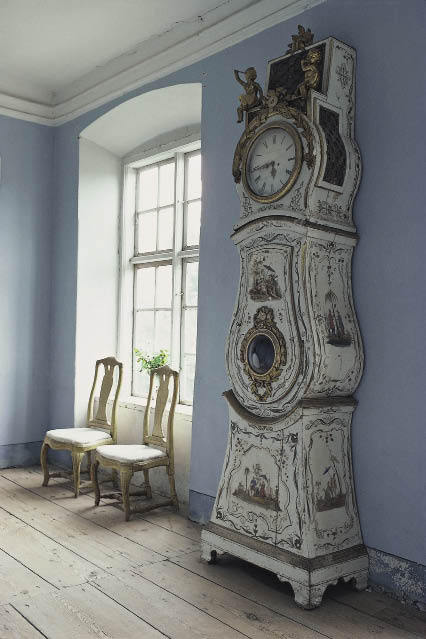For Jasper Conran the country is about ‘the scent of ripe apples or freshly-baked bread’, about grand houses that ‘sleep among ancient trees’, Morris dancers, Morris Travellers, tasteful cottages and ‘daffodils dancing in the breeze’. In his book Country (Conran Octopus, £50) there are some lovely interiors, though the most striking are those of his own former house in Chiswick. Conran’s acknowledgement of Andrew Montgomery, whose outstandingly beautiful photographs of landscapes, people and rooms transcend cliché to make this book such a pleasure, is churlishly scant.
Lars Sjöberg’s Classic Swedish Interiors (Frances Lincoln, £30) is a record of the eight houses and one church he has preserved from demolition or decay by buying and restoring them himself. Here, in Ingallil Snitt’s beautiful photographs, are the grey panelled rooms, the muslin curtains, the charming country versions of French 18th-century furniture that is known in Britain as the ‘Gustavian’ style. From his first purchase in 1966, Sjöberg has worked with his own hands, scraping back to the original wallpaper, re-making old furniture and discovering and re-printing old fabrics. He is a one-man National Trust of Sweden, and this book is a fine testimony to his 44 years of devoted work.
From the self-sacrificing (Sjöberg uses an earth closet in the garden rather than compromise the integrity of his manor house) to the frankly excessive. The decoration of the bedrooms and playrooms of the children of the very rich sounds like a handbook for a 21st-century Marie-Antoinette, and there is one ostrich-feathered bed shown in Room for Children by Suzanna Salk (Rizzoli, £30) which would not look out of place at Versailles. But it is a book full of inspiring decorative ideas, in fashionably bright colours and bold patterns which could serve as a decoration guide for many a grown-up bedroom or sitting room.
Naomi Cleaver provides a more prescriptive guide to re-designing your house in The Joy of Home (Conran/Octopus, £30), helping you analyse what you like and explaining how to achieve the result. Décor recipes and solid practical advice make this an invaluable interior decorating handbook.
Nobody really needs The Selby is in Your Place (Abrams, £22.50). But the author, Todd Selby, a fashion photographer who started photographing the houses of his super-cool chums, had a phenomenal success when he posted the pictures on his blog. It seems that lots of people wanted to peer into the lives of the crème of Dalston and their New York equivalents. The book shows them hanging out at home with their taxidermy (very popular), masks, religious symbols, bakelite telephones, white painted floors and brightly coloured walls, with added quips and answers to some unchallenging questions from Selby. It’s kitsch and quirky fun.
One could not call American Modern by Thomas O’Brien (Abrams, £30) kitsch by any stretch of the imagination. The owner of Aero, the New York design shop brimming with covetable objects, shows the interiors of seven houses he has designed, which share a pale colour palette and a lovely restrained elegance, though they vary in style from American colonial to 1930s Bauhaus. Laura Resen’s photography lingers over the details as O’Brien puts together objects on a bedside table as cleverly as a whole room. It is a delicious book and a very inspiring one too.
The life of Piero Fornasetti (1913–88), an Italian designer who started life as a surrealist painter, is celebrated in the massive Fornasetti: The Complete Universe by Mariuccia Casadio and Barnaba Fornasetti (Rizzoli, £180). So prolific was he that the headscarves, which were his first venture, could alone make a subject for a book; but then there are the umbrellas, ashtrays, ties, ceramic cats, plates, glasses, wallpapers, furniture, fabrics, and designs for the interiors of liners and hotels. These days he is perhaps best known for the range of china using the image of the 19th-century soprano Lina Cavalieri in heavily etched monochrome. She’s the face that launched 10,000 of his designs.






Comments